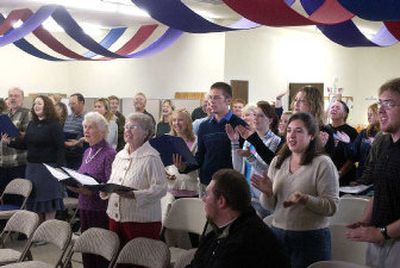Building house of worship

For almost 100 years, the Mead United Methodist Church has served countless families as a place of worship. It has moved locations, changed pastors, gained new congregants and lost some old ones, firmly weaving itself into the fabric of the community.
Now the “small church with a big heart,” is gearing up for a new home after giving up its last sanctuary – the old building on Farwell Road was located right in the way of the North-South freeway construction and had to be sold.
The church has been operating from a temporary structure at 12611 N. Wilson St. for more than two years. With the seats packed each Sunday, church leaders hope to break ground in the spring for a building that will accommodate a congregation of at least 200 people.
Pastor Peter Legner said the congregation must approve final building plans before construction can begin. The new church will cost $570,000 to build, Legner said. About $408,000 has already been collected, partly from the sale of the old property; the rest may be borrowed from the main United Methodist Church, but members must pledge to pay it back.
“From the time we decided on the plans building costs have gone up by $200,000. That was a huge thing we had no control of,” said Gayle Libutti, the staff-parish relations chairperson.
In the last few months, members have been busy with fund-raising activities. They held a giant yard sale and a dinner theater. Men from the church gathered a few weeks ago to cut wood, which they will sell to raise money.
Legner said the activities demonstrate the members’ commitment to working together.
“It’s been helping the church family be closer,” Legner said.
In its long history, this church has had many homes. It started out in 1883 at a one-room schoolhouse on the intersection of Bruce Road and Mount Spokane Highway in Peone Prairie, before the village of Mead came into being. Over the course of the early 1900s, the “Ladies Aid” Society collected money to build a permanent church, a brick building that was finally completed in 1904. The pastor at Mead also served other outlying communities like Greenbluff and East Peone. Right after WWII, it was the only Methodist church in Mead, according to church historical records.
To accommodate its expanding membership and provide a place for social activities, the church even bought an old tavern on Market and First Street in 1956, which was converted into a youth center. Services were held at the old tavern in 1957, after a fire smoldered part of the main church.
Over the years, the church faced numerous tribulations – during the 1940s for instance, the flock went without a pastor of their own, having to depend on visiting and temporary pastors. Financial strife also made it difficult for the church to meet some of its payment obligations. The old brick church was sold in 1958, and the church was only able to get the building that stood on Farwell in 1969.
With state plans to build a new highway, the church sold that property to the Washington Department of Transportation and the sanctuary was burned down as an exercise for the Fire Department, Libutti said.
“All that is left of our former home is the one lone birch tree that still stands in the midst of the new freeway construction,” Libutti said in an e-mail.
Worshippers like Anna Kenney have witnessed the church’s shifting tides.
“They’ve been a lot changes and no changes,” said Kenney, who has been with the church for more than 50 years. “Faces change, and people come, go and people come back.”
Kenney, who has held several positions, is currently the Saturday service worship leader. This additional service offers some flexibility for those who might not be able to attend on Sunday morning, Kenney said.
“This is my church … this church is like family,” she said.
The new construction will have three phases – the main sanctuary, classrooms and finally a fellowship hall. Legner said he hopes it will be an adequate space for the growing membership.
“The strength of our church is that it really has a diversity of age groups,” Legner said. “It’s a lively dynamic church. You don’t feel like you have to dress a certain way or act a certain way.”
“People feel comfortable even if there are differences,” Libutti said. “It’s a very accepting church. They are no big rules.”
Legner and Libutti said the church wants to reach out to the Mead community and make people feel welcome. The church has an open house on the first Thursday evening of every month and members sometimes go door to door. The church also shares its space with some of the Marshall Islanders, who hold their own services there on Sunday evenings since they don’t have a building of their own.
The Mead Food Bank also is located at the church and is open Wednesdays from 4 to 7 p.m. Although it is not officially a part of the church, it was started by Bette Monahan and Rory-Anne Cudney, long-term members of the congregation. Cudney said the food bank which is a subsidiary of Second Harvest, serves about 35 families a week.
“I think there is a sense that we’re doing the right thing as a church,” Legner said. “We’re trying to be faithful to Jesus Christ as a church.”
“It will be so good when we’re out there and visible and people can see us,” Libutti said. “The spirit is really alive here.”